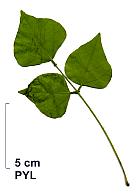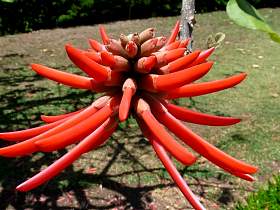Erythrina caffra

tree of the family Fabaceae
 Etymology: The name comes from the Greek Erythrina, erythrose , which means 'red', referring to the color of the flower, and caffra, name of African civilization which is native Erythrina. Etymology: The name comes from the Greek Erythrina, erythrose , which means 'red', referring to the color of the flower, and caffra, name of African civilization which is native Erythrina.
Origin: East Coast of South Africa, formerly known as Country of Caffres or Kaffraria.
Habitat: Erythrina requires drained soil, humus, fresh to moist (except in winter), fertile or rich, acidic or neutral or alkaline. It enjoys a location in full sun, sheltered from the wind to protect its flowering.
Hardiness: Zone 10 (it supports cold to 0 °).
Growth: Fast.
Maximum size: 9-12 m tall.
Form: upright and spreading, rounded crown in older subjects.
Trunk, branches spiny.
Bark: fissured in braces.
Semi-evergreen foliage. Large leathery leaves, dark green, slightly bluish composed of 3 leaflets oblong-lanceolate, spiny petiole.
Flowers appear in late spring or early summer (May-August) only in the relatively warm regions (eg Mediterranean basin). Large flowers of pea (about 5 cm), red coral, grouped in terminal clusters erected, which attract birds.
Fruits: pods ensheathing cylindrical, brownish at maturity, following the shape of oval seeds.
Tradition: the Erythrina caffra is the emblem of the city of Los Angeles, California, United States of America.
Planting tips: Plant your Erythrina caffra in spring outdoors in a mild climate, and elsewhere keep it in a pot under greenhouse.
 The Erythrina coralloides is a shrub up to 5 m high, native to Mexico. The Erythrina coralloides is a shrub up to 5 m high, native to Mexico.
Its flower, appearing in spring, has a remarkable red color.
Evergreen foliage. |

![]()

![]()

![]()

![]()

![]()

![]()